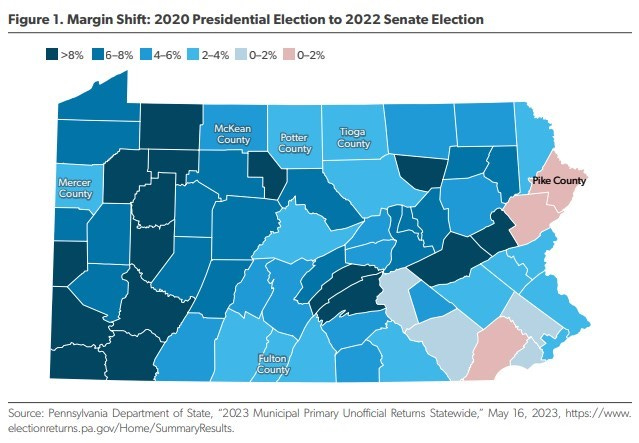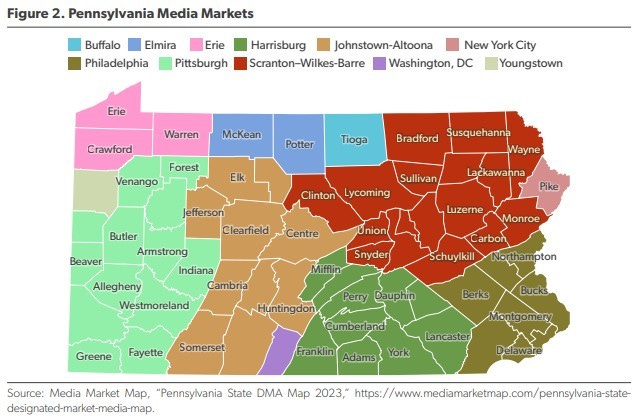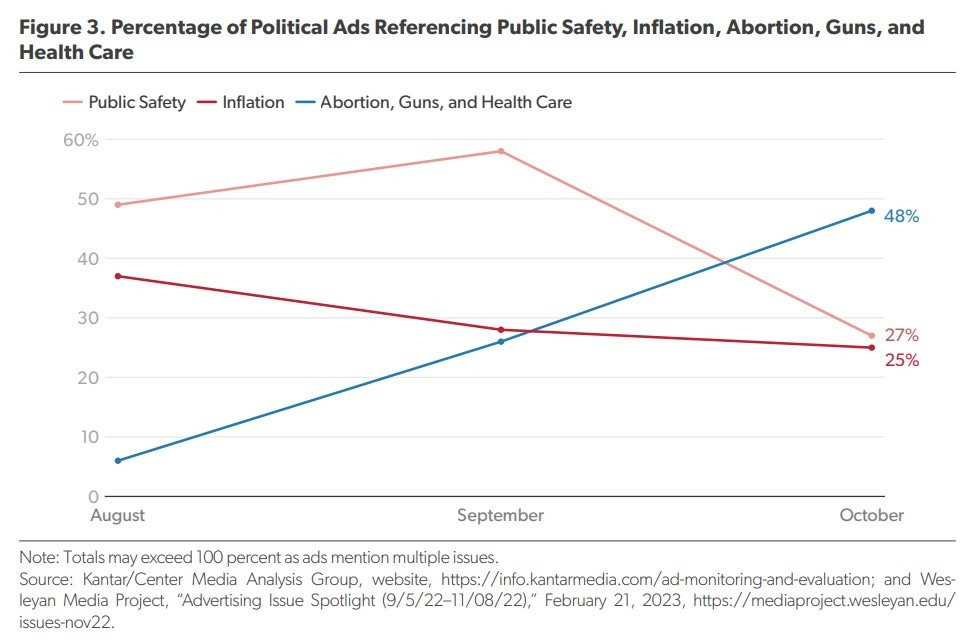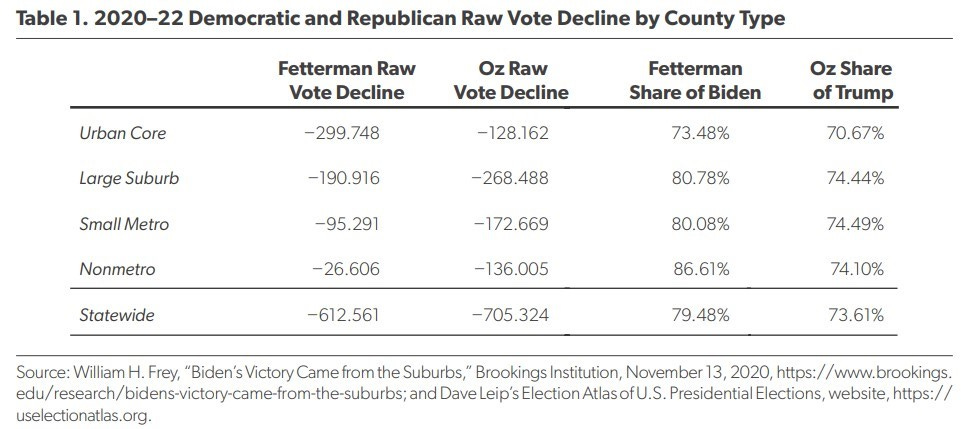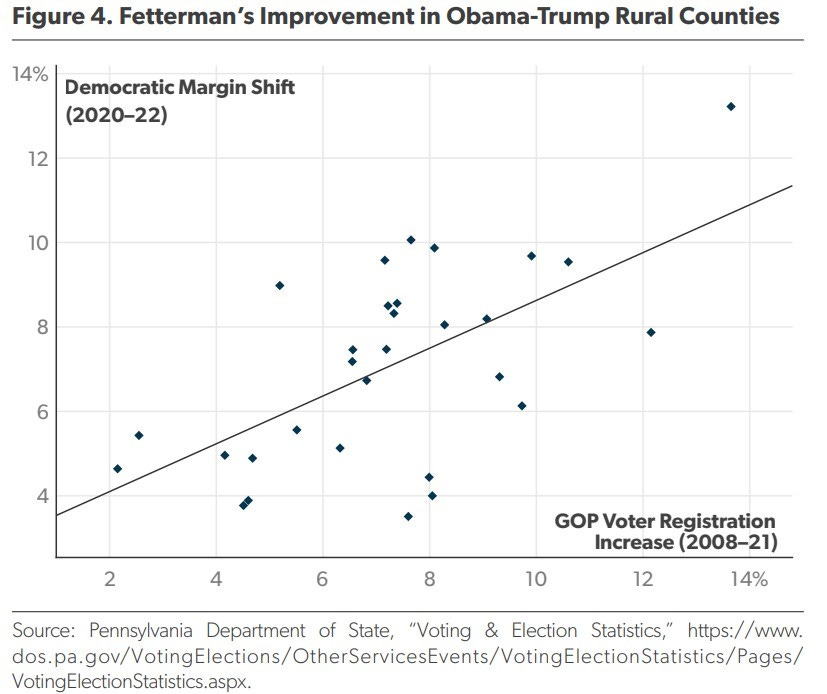Oz, Fetterman, and the Future of Pennsylvania Politics
Candidate Quality Matters. A Lot.
This post is based on a new report breaking down the data from the 2022 Pennsylvania Senate race. The full report can be read here.
The most impressive Democratic over-performance of the 2022 midterms came in the perennial presidential battleground of Pennsylvania. In a state rarely decided by more than a couple points in either direction, John Fetterman’s five-point win over Mehmet Oz shattered even the most optimistic of Democratic projections. In the other marquee statewide race, Josh Shapiro beat state Sen. Doug Mastriano for the governor’s seat by an astounding 15 points. As Democrats rejoiced, Pennsylvania Republicans were left wondering what had gone wrong.
Media Matters
The Oz-Fetterman race was the second most expensive Senate race in history. Each of their campaigns, and the dozens of super political action committees (PACs) on both sides, flooded Pennsylvania with mailers, television ads, and get-out-the-vote efforts. Total spending exceeded $400 million. Advertising, in particular, helped carry Fetterman to his eventual five-point victory. Pennsylvania contains six primary media markets: Erie, Harrisburg, Johnstown-Altoona, Philadelphia, Pittsburgh, and Scranton–Wilkes-Barre. Candidates devote the vast majority of spending to these media markets, rather than waste valuable dollars on the few counties in largely out-of-state markets. This dichotomy creates a natural, if imperfect, testing ground on the efficacy of political advertising.
Figure 1 shows the margin shift between Biden’s victory and Fetterman’s. While nearly the entire state shifted left, the county-level variations convincingly correlate to media markets. The six counties that dodged most television advertising shifted leftward by 3.4 points. The remaining 61 counties shifted left by an average of 6.4 points. On average, the more voters learned of the two candidates, the more likely they were to vote for Fetterman.
Mercer County offers an interesting case study. As shown in Figure 2, Mercer is part of the Youngstown media market, one of Pennsylvania’s smaller media markets. Mercer’s four neighboring counties—Butler, Craw-ford, Lawrence, and Venango—are split between the Erie and Pittsburgh media markets and shifted 8.1 points toward Fetterman. Mercer, however, spared from incessant advertising, shifted to Fetterman by only four points. The five aforementioned counties are demographically quite similar—suggesting advertising produced dramatically different Senate results.
Issue advertising also plays an important electoral role. Rising violent crime, for example, should have been a home-run issue for the Pennsylvania GOP. Philadelphia and Pittsburgh both recorded historically high homicide numbers in 2022. Overall, violent crime, and particularly armed robberies, spiked compared to previous years. With progressive District Attorney Larry Krasner at the helm in Philadelphia, the conservative attack ads could have written themselves. But the Oz campaign failed to capitalize on this.
As Figure 3 illustrates, public-safety ads were prominent in Pennsylvania during August and September, far outpacing Democratic-leaning issues such as abortion, gun safety, and health care. In the closing stretch of the campaign, however, as the total number of ads increased, the share of public-safety airings cratered to a measly 27 percent. Meanwhile, the total share for pro-Democratic issues skyrocketed to 48 percent in October. Voters saw nearly two abortion, gun control, or health care ads for every one public-safety ad. The Fetterman campaign had a pure volume advantage as well. Between Labor Day and Election Day, 63,868 Senate ads aired in Pennsylvania. Of those, 37,055 were from Fetterman—a 10,242 ad advantage for the Democrat.
The limited public-safety messaging proved costly for Oz. Only 8 percent of Pennsylvania voters listed crime as their most important issue, compared to 15 percent in New York, where 42 percent of October ads related to crime. Meanwhile, 12 percent of Pennsylvania voters picked abortion as their most important concern. Health care and climate change were not far behind at 7 percent each. Even those voters who listed crime as the top issue preferred Oz by just 12 points, a far cry from the disparity the GOP was hoping to establish. Despite claims to the contrary, crime was not a particularly salient issue in the 2022 Pennsylvania Senate race—to Oz’s great detriment.
Rural Recovery
Fetterman’s greatest success—or, perhaps more accurately, Oz’s greatest shortcoming—came in Pennsylvania’s rural counties.
As Table 1 illustrates, vote totals declined across the state compared to the 2020 presidential election. But across the four county groups—urban, suburban, small metro, and nonmetro—Fetterman was far closer to matching Biden’s raw vote totals than Oz was to matching Trump’s. Across the 30 counties classified as rural (nonmetro), Fetterman received 26,606 fewer votes than Biden did. Oz, on the other hand, saw a 136,005 vote decrease from Trump. The 12.5-point gap between Fetterman’s share of Biden’s rural vote and Oz’s share of Trump’s rural vote is the largest of any of the four county types.
The average rural county moved toward Fetterman by 7.1 points relative to Biden’s performance, compared to an average of 6.1 points toward Fetterman in suburbs of large metro areas, 4.6 points in small metro areas, and just 3.7 points in urban areas. Intriguingly, rural counties, where Fetterman’s margin improvement was the largest, also have the heaviest concentrations of white working-class voters. These counties average 77 percent white working-class adults, 17 percent white college graduates, and only 6 percent non-white adults. A good example is rural and conservative Warren County, in the northwest corner of Pennsylvania, which is 79 percent white working-class voters and swung 10 points toward Fetterman.
One fascinating question is how much of Fetterman’s relative rural success was owed to persuading Republicans rather than simply mobilizing Biden supporters. Fox News/Associated Press (AP)/NORC VoteCast data offer a good place to start: 9 percent of self-identified Republicans voted for Fetterman, compared to 3 percent of self-identified Democrats supporting Oz. But VoteCast offers little information about the type of Republican who voted for Fetterman.
To approximate the number of Obama-Trump voters in each county, we use net Republican voter registration gain from 2008 to 2021 as a share of total registered voters. Republicans increased their share of registered voters in all 30 rural counties, but the net gain ranged from 2 percent to almost 14 percent. Counties with a larger increase in Republican voters are likely home to more Obama–Trump voters. Fetterman’s campaign rhetoric and style were explicitly designed to win over these once-Democratic counties that have shifted right rapidly over the past 15 years. County-level swing from 2020 to 2022 is plotted against 13 years of GOP voter registration gains in Figure 4.
The correlation is clear. The Fetterman campaign did better in counties with larger increases in GOP voter registration—and by extension, counties with many Obama–Trump voters. Figure 4 provides convincing evidence that Pennsylvania Democrats’ rural over-performance in 2022 is at least in part owed to Obama–Trump voters voting blue once again. Many national Democrats have written off these voters, but the 2022 Senate race proves a chunk of rural white working-class voters will indeed support a Democratic with the right aesthetic and messaging.
Oz did not put up a good fight in the persuasion and mobilization wars. Despite his extremely limited campaigning, Fetterman generated a more enthusiastic response from his respective base. Oz’s struggles with the base included 126,000 fewer rural votes than Trump, half of which could have erased his margin of defeat. Just as Democrats must work to earn back the votes of the rural working class, Republicans must not take their growing success among the group for granted.
Fetterman’s Minority Struggles
The Oz-Fetterman story is incomplete without a look at minority voting patterns. According to VoteCast data, in 2020, Biden carried Pennsylvania’s black voters 94 percent to 5 percent (an 89-point advantage), but Fetterman won black voters by just 87 percent to 10 percent (a 77-point advantage) in 2022—a 12-point swing against Democrats. Among Hispanic voters, Biden beat Trump 65 percent to 35 percent (a 30-point advantage), while Fetterman carried the group just 55 percent to 41 percent (a 14-point advantage)—a dramatic 16-point swing toward Republicans. As a whole, non-white voters shifted 14 points to the right between 2020 and 2022, driven by an enormous 21-point swing toward the GOP among non-white working-class (noncollege) voters. Fetterman’s victory derived primarily from a strong performance among white voters.
Turnout presented problems for Fetterman as well. Low minority turnout, especially black turnout, has long been a hurdle for Democratic candidates in midterm years. In the post-Obama era, few candidates have energized the core Democratic base of black voters anywhere close to 2008 or 2012 levels. But even accounting for expected differential turnout, Pennsylvania’s minority turnout was especially low in 2022—a warning sign for Democratic candidates in future cycles.
Turnout was even poorer in Philadelphia’s majority-Latino wards. Latinos, who comprise 16 percent of the city as a whole, are primarily concentrated in working-class northeastern neighborhoods. In the four wards with the largest share of Hispanic voters, turnout averaged an abysmal 49.4 percent of 2020 totals. A turnout drop of more than 50 percent is shocking, especially as statewide turnout remained so high and hundreds of millions of dollars poured into the Philadelphia media market. If Pennsylvania Democrats continue to ignore Latinos’ concerns, they risk a repeat of 2022’s rightward swing in 2024.
Presidential Roles
Trump and Biden played an incredibly important role in the 2022 Pennsylvania Senate race. The Oz campaign relentlessly tried to nationalize the race by connecting Fetterman to Biden. Fetterman as a senator would be nothing more than a rubber stamp for the left-wing Biden agenda, argued the Oz campaign. The rationale behind such strategy was simple: Biden’s approval rating hovered in the low 40s. If Pennsylvanians cast their ballots based on their perceptions of the president, Oz would win.
Biden’s disapproval rating among 2022 midterm voters was 60 percent. Just 14 percent of voters strongly approved of his job performance, while 45 percent strongly disapproved. But Fetterman was able to overcome this imbalance with an exceedingly strong performance among the “meh” voters—those who somewhat approve or disapprove. Fetterman carried the “somewhat approve” crowd by a whopping 92-point margin. More impressively, he won those who “somewhat disapprove” by 28 points—61 percent to Oz’s 33 percent. Soft disapproval of Biden was not a particularly salient factor in Senate vote choice. Plenty of Pennsylvanians disliked Biden but still voted blue up and down the ballot in 2022.
Oz’s proximity to Trump appears not to have affected rural margins but still hurt him with the majority of Pennsylvania residents who view the former president as politically toxic. Fetterman, meanwhile, was not dragged down by Biden’s low approval ratings. In 2022, at least to Pennsylvania Senate voters, Trump was largely synonymous with the down-ballot GOP, while Democrats were able to establish a brand independent of an unpopular incumbent.
Conclusion
Cynicism abounds amid record polarization, but the 2022 midterms in Pennsylvania reinforced that candidate quality matters. The GOP’s nomination of Oz and Mastriano—when matched against a pair of surprisingly strong Democrats in Fetterman and Shapiro—proved electorally disastrous. Up and down the ballot, the Republican Party will be much better served by running candidates who are not proven electoral losers. In the 2024 presidential contest, Pennsylvania will likely snap back to its battleground status, but the GOP must not forget the lessons of 2022.
The full report has much more detailed data and analysis on this critical Senate race! It is available on the American Enterprise Institute website.




